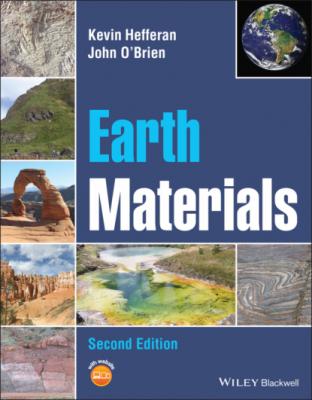Earth Materials. John O'Brien
Читать онлайн.| Название | Earth Materials |
|---|---|
| Автор произведения | John O'Brien |
| Жанр | География |
| Серия | |
| Издательство | География |
| Год выпуска | 0 |
| isbn | 9781119512219 |
Figure 4.24 Five common forms in the isometric system: (a) cube, (b) octahedron, (c) dodecahedron, (d) tetrahedron, (e) pyritohedron.
Many other forms exist. Every crystal form has a form index, which is the Miller index of the form face placed in brackets. Each form consists of one or (generally) more faces and each face possesses a Miller index different from that of every other face in the form. Every crystal system has a characteristic suite of forms that reflect the unique characteristics of the crystal lattice of the system, especially the relative lengths of the three crystallographic axes that directly or indirectly reflect the lengths of the unit cell edges. The forms that are characteristic of each class (space point group) in each crystal system are beyond the scope of this text (see Klein and Hurlbut 1985). However, a brief review of some common forms in each crystal system is appropriate.
4.6.7 Common crystal forms in each system
Isometric (cubic) system forms
All forms in the isometric system are closed forms. Common crystal forms in the isometric system include the cube, octahedron, dodecahedron, tetrahedron, and pyritohedron (Figure 4.24). These forms may occur alone or in combination with each other. Common isometric minerals, their crystal forms, and form indices are summarized in Table 4.6.
These form indices are also used to describe cleavage in isometric minerals. These minerals include halite and galena, which possess cubic cleavage {001} with three orientations of cleavage at right angles; fluorite, which possesses octahedral cleavage {111} with four cleavage orientations; and sphalerite, which possesses dodecahedral cleavage {011} with six orientations of cleavage.
Table 4.6 Common isometric crystal forms, form indices, form descriptions, and minerals.
| Crystal form | Form indices | Form description | Minerals that commonly exhibit crystal form |
|---|---|---|---|
| Cube | {001} | Six square faces | Halite, galena, pyrite, fluorite, cuprite, perovskite, analcite |
| Octahedron | {111} | Eight triangular faces | Spinel, magnetite, chromite, cuprite, galena, diamond, gold, perovskite |
| Dodecahedron | {011} | 12 diamond‐shaped faces | Garnet, sphalerite, sodalite, cuprite |
| Tetrahedron |
|
Four triangular faces | Tetrahedrite, sphalerite |
| Pyritohedron | {h0l} | 12 pentagonal faces | Pyrite |
Figure 4.25 Common crystal forms in the tetragonal crystal system: (a) tetragonal prism in combination with a pinacoid, (b) tetragonal dipyramid, (c) tetragonal dipyramid in combination with a tetragonal prism.
Table 4.7 Common tetragonal crystal forms, form indices, form descriptions, and minerals.
| Crystal forms | Form indices | Form description | Minerals that commonly exhibit crystal form |
|---|---|---|---|
| Tetragonal dipyramid | {111} {hh1} {011} {0kl} and variations | Eight triangular faces; top four separated from bottom four by mirror plane | Zircon, rutile, cassiterite, scheelite, wulfenite, vesuvianite, scapolite |
| Tetragonal prism | {010} {110} and variations | Four rectangular faces parallel to c‐axis | Zircon, scheelite, vesuvianite, rutile, malachite, azurite, cassiterite, scapolite |
| Tetragonal disphenoid | {0kl} | Four triangular faces; alternating pairs symmetrical about c‐axis | Chalcopyrite |
| Basal pinacoid | {001} | Pair of faces perpendicular to c‐axis | Vesuvianite, wulfenite |
Tetragonal system forms
Tetragonal crystals can possess closed and/or open forms. Common closed crystal forms in the tetragonal crystal system include different eight‐sided dipyramids. Common open forms include four‐sided and eight‐sided prisms and pyramids, as well as pinacoids and pedions. Typical crystal forms and associated minerals in the tetragonal crystal system are shown in Figure 4.25 and Table 4.7.
Hexagonal system (hexagonal division) forms
Common crystal forms in the hexagonal system include 6–12‐sided prisms, dipyramids, and pyramids. Pinacoids and pedions are also common. Some selected examples of common crystal forms and minerals in the hexagonal system are illustrated in Figure
